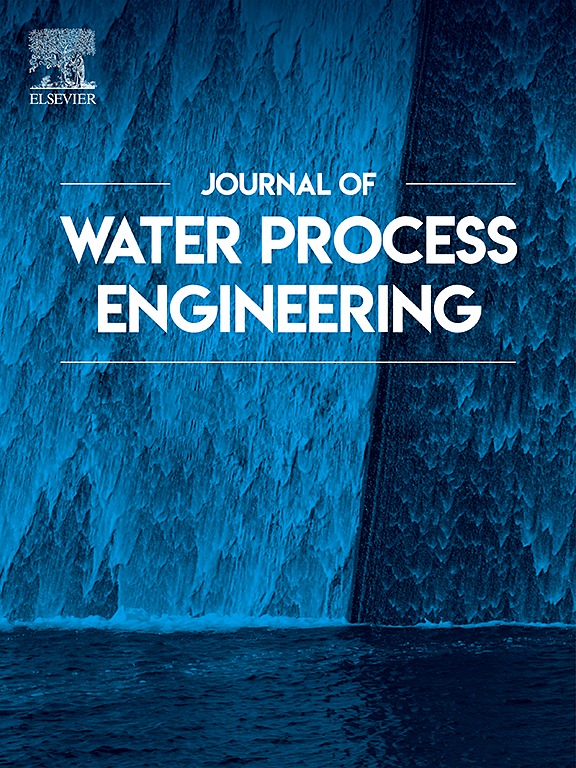Insights into phosphate removal and recovery from wastewater using biosolids biochar: Pyrolysis optimisation, mechanistic and column studies
IF 6.3
2区 工程技术
Q1 ENGINEERING, CHEMICAL
引用次数: 0
Abstract
Biosolids, or sewage sludge (SS), is a byproduct from wastewater treatment plants (WWTPs) and drinking water production. SS can contain contaminants, which often generates secondary pollution post-disposal; therefore, pyrolysis is a promising approach for industrial-scale SS management (when compared to incineration, landfill, and direct agricultural use). Here, we determined optimal SS pyrolysis conditions using a Response Surface Methodology approach taking into consideration SS type, pyrolysis temperature and time. An optimised SS biochar (SSB-O) was then characterised using SEM-EDX, TGA/DSC, BET, FTIR, XRD and XPS. The biochar was then applied to phosphate adsorption from wastewater. Adsorption/desorption for phosphate (PO43−-P) was evaluated through a series of batch and dynamic experiments using artificial and real WWTP effluent. Results showed that high PO43−-P removal was achieved with a qmax,exp of 12.7 mg/g in equilibrium studies, and the SSB-O was able to bring residual effluent PO43−-P below 0.5 mg Ptotal/L or 90 % of Ptotal have been removed (new EU Urban Wastewater Treatment Directive 2024/3019). In column experiments, breakthrough time (for effluent P concentration < 0.1 mg/L) was 11,520 min (192 h) for an EBCT of 30 min, which corresponded to 668 Bed Volumes. Instrumental characterisation indicated that adsorption mechanisms were dominated by inner-sphere complexation onto metal ligands (mostly with aluminium). The work showed that SSB-O produced from a WWTP where an aluminium rich drinking water sludge was recirculated through the plant resulted in the best biochar, which could then serve as a water treatment material and as a medium to recover PO43−-P from WWTP effluents.
使用生物固体生物炭从废水中去除磷酸盐和回收的见解:热解优化,机制和柱研究
生物固体或污水污泥(SS)是废水处理厂(WWTPs)和饮用水生产的副产品。SS可能含有污染物,往往会产生二次污染;因此,热解对于工业规模的SS管理(与焚烧、填埋和直接农业使用相比)是一种很有前途的方法。本文采用响应面法,综合考虑SS类型、热解温度和时间,确定了SS的最佳热解条件。然后利用SEM-EDX、TGA/DSC、BET、FTIR、XRD和XPS对优化后的SS生物炭(SSB-O)进行表征。然后将生物炭用于废水中的磷酸盐吸附。通过一系列的间歇和动态实验,评价了污水处理厂人工污水和真实污水对磷酸(PO43−p)的吸附/解吸作用。结果表明,在平衡研究中,SSB-O达到了12.7 mg/g的高PO43−p去除率,并且能够将残余出水PO43−p降低到0.5 mg/ L以下或90%的Ptotal已被去除(新的欧盟城市废水处理指令2024/3019)。柱式实验中,出水P浓度突破时间<;0.1 mg/L)为11,520 min (192 h), EBCT为30 min,相当于668床体积。仪器表征表明,吸附机制主要是在金属配体(主要是铝)上的球内络合。研究表明,在污水处理厂中,富铝饮用水污泥通过工厂再循环产生的SSB-O产生了最好的生物炭,然后可以作为水处理材料和从污水处理厂流出物中回收PO43−p的介质。
本文章由计算机程序翻译,如有差异,请以英文原文为准。
求助全文
约1分钟内获得全文
求助全文
来源期刊

Journal of water process engineering
Biochemistry, Genetics and Molecular Biology-Biotechnology
CiteScore
10.70
自引率
8.60%
发文量
846
审稿时长
24 days
期刊介绍:
The Journal of Water Process Engineering aims to publish refereed, high-quality research papers with significant novelty and impact in all areas of the engineering of water and wastewater processing . Papers on advanced and novel treatment processes and technologies are particularly welcome. The Journal considers papers in areas such as nanotechnology and biotechnology applications in water, novel oxidation and separation processes, membrane processes (except those for desalination) , catalytic processes for the removal of water contaminants, sustainable processes, water reuse and recycling, water use and wastewater minimization, integrated/hybrid technology, process modeling of water treatment and novel treatment processes. Submissions on the subject of adsorbents, including standard measurements of adsorption kinetics and equilibrium will only be considered if there is a genuine case for novelty and contribution, for example highly novel, sustainable adsorbents and their use: papers on activated carbon-type materials derived from natural matter, or surfactant-modified clays and related minerals, would not fulfil this criterion. The Journal particularly welcomes contributions involving environmentally, economically and socially sustainable technology for water treatment, including those which are energy-efficient, with minimal or no chemical consumption, and capable of water recycling and reuse that minimizes the direct disposal of wastewater to the aquatic environment. Papers that describe novel ideas for solving issues related to water quality and availability are also welcome, as are those that show the transfer of techniques from other disciplines. The Journal will consider papers dealing with processes for various water matrices including drinking water (except desalination), domestic, urban and industrial wastewaters, in addition to their residues. It is expected that the journal will be of particular relevance to chemical and process engineers working in the field. The Journal welcomes Full Text papers, Short Communications, State-of-the-Art Reviews and Letters to Editors and Case Studies
 求助内容:
求助内容: 应助结果提醒方式:
应助结果提醒方式:


